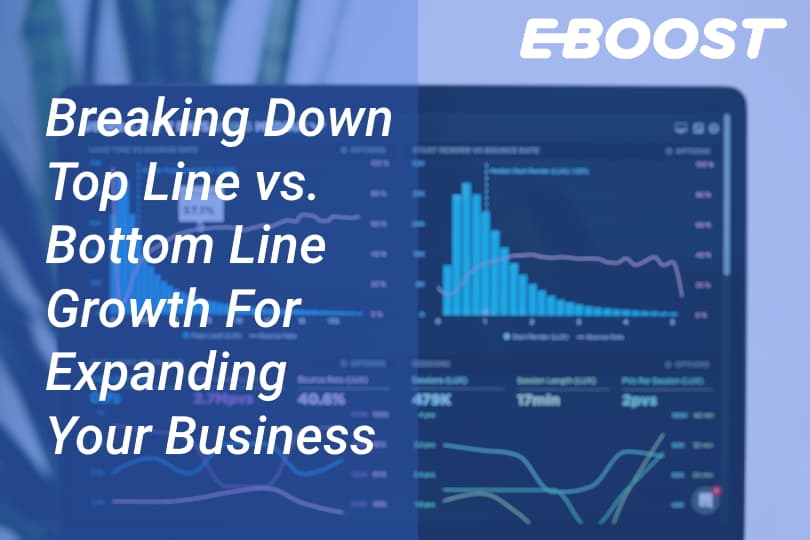
Two of the most fundamental variables on your business’s income statement are its bottom line and top line. The bottom line of a company tells you what that business’s net income is. On the other hand, the top line shows a business’s gross revenues —before subtracting operating expenses— from total product sales, services rendered, or both.
Top-line growth is the rise in revenue generated by a business’s primary commercial activities. The bottom line “growth,” by contrast, reveals how well a business manages its spending and operational costs.
In this post, we define the bottom line and top line, examine how they vary, go through strategies for expanding each, and demonstrate how to compute the bottom line using the top line.
What Is the Top Line?
The phrase “top line” refers to a business’s revenue figures because revenues are listed at the top of an income statement. When a business experiences “top-line growth,” it means that its revenues or gross sales have increased. To increase your business’s top line:
- Invest in converting new prospects into paying customers through advertising.
- Expand into new and untapped markets y offering new products or services.
- Improve the quality of your deliverables to organically generate word-of-mouth advertising and repeat business.
- Raise the price of your products and services; if done right this can raise consumers’ perception of the quality of your products and services all on its own.
The top line reflects how well the business generates sales. It is a straightforward gross sales figure that shows how much money the business made within a specific time frame. Potential operating inefficiencies that impact the company’s bottom line are not taken into account when making top-line-only analyses. As a result, the top line does not account for costs paid by the business to produce products, such as the cost of goods sold (COGS). Neither does it reflect the impact of any discounts or reductions from returns.
What Does Top Line Revenue Mean?
Businesses in their early stages usually need to focus on growth at all costs. Quickly increasing top-line growth as much as possible lets a business gain market share and take advantage of the market potential, both of which are enticing to investors.
Based on how you analyze the business’s revenue statistics, you can use top-line data to help sales and marketing determine whether their target market is being reached, whether their sales strategies are effective and whether their advertisements and marketing efforts are producing new leads that actually result in sales.
See Also:
What Is the Bottom Line in Business?
The “bottom line” is so-called because net income is frequently the last number shown on an income statement. In other words, the bottom line of business ventures is defined as the business’s bottom line revenue minus expenses, such as:
- Interest on debts
- Fixed costs for administration and overhead
- COGS, including labor and materials
- Depreciation and amortization
- Income taxes
The term “bottom line” can also refer to a business’s net earnings or profits.
By cutting costs, a business can boost its bottom line; products can be manufactured using new, more affordable input materials or through more efficient production techniques. Other ways to enhance the bottom line of a company include lowering employee pay and benefits, using less costly facilities, leveraging tax breaks, and lowering the cost of capital.
A Closer Look: What Does the Bottom Line Mean in Business?
When a business is more mature, the focus shifts away from pure top-line growth at all costs towards greater growth in the efficiency of production processes and systems. Mature businesses focus more on profit margin and net income when assessing the state of their finances. At the end of the day, any profitable business needs to have both a strong profit margin and a sizable bottom line.
Your business’s bottom line can be utilized to distribute dividends to investors Alternatively, your bottom line figure can be used for product development, location expansion, equipment acquisition, or any number of other investments for improving the company.
To determine the bottom line of business you’ll first need to know its top line once you have that, you can simply plug in the figures to use the formula below:
Bottom Line = Top Line – Total Expenses
The Difference Between the Top Line and Bottom Line
Knowing what plays into a business’s top and bottom lines helps investors and lenders judge if a company’s management is increasing sales and revenue while properly controlling expenditures. The same business decisions can differently affect how quickly the bottom line and top line increase.
When making a top line vs. bottom line analysis of your business, you need to use both numbers to measure its commercial performance, as each is important for separate purposes. The top line lets you see how much your business revenues have grown, while the bottom line of a company shows how well it is able to make products or render services to generate profit sufficient to offset overhead costs and produce a respectable net profit.
The bottom line can be used by businesses to finance expansion, pay dividends to shareholders, or make new investments. The top line is where businesses can draw funds for their operating budgets covering expenditures such as salaries, taxes, and overhead.
Highly profitable companies generally see to it that there is growth in both their top and bottom lines. Even with stagnant revenues, established businesses may still improve their bottom line by, instead, cutting costs —cost-cutting methods are usually resorted to when the economy is slow.
Conclusion — What Is More Important: Bottom Line or Top Line Sales?
The gap between top-line and bottom-line growth reveals how much you are spending to create a profit, allowing you to assess costs, reinvent budgets, and make the most of your business.
While both the top and bottom lines are significant metrics for businesses to monitor, startups focused on increasing sales may find the top line to be more pertinent. A stronger emphasis on the bottom line may be used by more mature businesses to develop sustainable economic strategies.
Along a similar line, E-Boost is here to help you develop an economic strategy for the success of your small business. Our consultants are just a call away—reach out, and we’ll show you how our financial toolkit can boost your business. From working capital, lines of credit, online banking, and more, E-Boost is your one-stop solution for small business funding.
